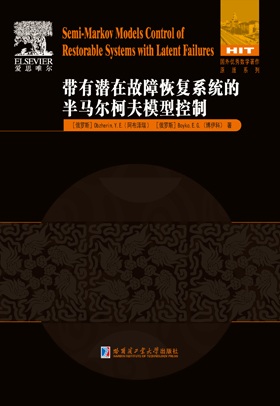【目 录】
Preface v
List of Notations and Abbreviations vii
Introduction ix
1. Preliminaries 1
1.1 Strategies and Characteristics of Technical Control 1
1.2 Preliminaries on Renewal Theory 2
1.3 Preliminaries on Semi-Markov Processes with Arbitrary Phase
Space of States 5
2. Semi-Markov Models of One-Component Systems
with Regard to Control of Latent Failures 13
2.1 The System Model with Component Deactivation
while Control Execution 14
2.1.1 The System Description 14
2.1.2 Semi-MarkovModelBuilding14
2.1.3 Defi nition of EMC Stationary Distribution 16
2.1.4 Stationary Characteristics Defi nition 17
2.2 The System Model without Component Deactivation
while Control Execution 22
2.2.1 The System Description 22
2.2.2 Semi-MarkovModelBuilding22
2.2.3 Defi nition of EMC Stationary Distribution 24
2.2.4 Stationary Characteristics Defi nition 26
2.3 Approximation of Stationary Characteristics of One-Component
System without Component Deactivation 34
2.3.1 System Description 34
2.3.2 Semi-MarkovModelBuildingof the Supporting System 34
2.3.3 Defi nition of EMC Stationary Distribution for Supporting
System 36
2.3.4 Approximation of the System Stationary Characteristics 37
2.4 The System Model with Component Deactivation and
Possibility of Control Errors 42
2.4.1 System Description 42
2.4.2 Semi-MarkovModelBuilding43
2.4.3 Defi nition of EMC Stationary Distribution 45
2.4.4 System Stationary Characteristics Defi nition 46
2.5 The System Model with Component Deactivation and
Preventive Restoration 53
2.5.1 System Description 53
2.5.2 Semi-MarkovModelBuilding54
2.5.3 Defi nition of the EMC Stationary Distribution 56
2.5.4 Defi nition of the System Stationary Characteristics 58
3. Semi-Markov Models of Two-Component Systems
with Regard to Control of Latent Failures 63
3.1 The Model of Two-Component Serial System with Immediate
Control and Restoration 64
3.1.1 System Description 64
3.1.2 Semi-MarkovModelBuilding64
3.1.3 Defi nition of EMC Stationary Distribution 66
3.1.4 Stationary Characteristics Defi nition 70
3.2 The Model of Two-Component Parallel System with Immediate
Control and Restoration 81
3.2.1 System Description 81
3.2.2 Defi nition of System Stationary Characteristics 81
3.3 The Model of Two-Component Serial System with Components
Deactivation While Control Execution, the Distribution of
Components Operating TF is Exponential 88
3.3.1 System Description 88
3.3.2 Semi-MarkovModelBuilding88
3.3.3 Defi nition of EMC Stationary Distribution 90
3.3.4 Stationary Characteristics Defi nition 92
3.4 The Model of Two-Component Parallel System with
Components Deactivation While Control Execution, the
Distribution of Components Operating TF is Exponential 99
3.4.1 Defi nition of EMC Stationary Distribution 100
3.5 Approximation of Stationary Characteristics of
Two-Component Serial Systems with Components
Deactivation While Control Execution 104
3.5.1 System Description 104
3.5.2 Semi-MarkovModelBuildingof the Initial System 105
3.5.3 Approximation of the Initial Stationary Characteristics 106
4. Optimization of Execution Periodicity of Latent
Failures Control 117
4.1 Defi nition of Optimal Control Periodicity for
One-Component Systems 117
4.1.1 Control Periodicity Optimization for One-Component
System with Component Deactivation 118
4.1.2 Optimal Control Periodicity for One-Component
System Without Deactivation 120
4.1.3 Control Periodicity Optimization for One-Component
System with Regard to Component Deactivation and
Control Failures 121
4.2 Defi nition of Optimal Control Periodicity for Two-Component
Systems 122
4.2.1 Control Periodicity Optimization for Two-Component
Serial System 122
4.2.2 Control Periodicity Optimization for Two-Component
Parallel System 124
5. Application and Verification of the Results 127
5.1 Simulation Models of Systems with Regard to Latent
Failures Control 127
5.1.1 Comparison of Semi-Markov with Simulation
Model in Case of One-Component System 128
5.1.2 Comparison of Semi-Markov with Simulation
Model in Case of Two-Component System 128
5.2 The Structure of the Automatic Decision System for
the Management of Periodicity of Latent Failures Control 129
5.2.1 Description of ADS CPM of Latent Failures Operation 131
5.2.2 Passive Industrial Experiment 133
6. Semi-Markov Models of Systems of Different Function 139
6.1 Semi-Markov Model of a Queuing System with Losses 139
6.1.1 System Description 139
6.1.2 Semi-MarkovModelBuilding140
6.1.3 EMC Stationary Distribution Determination 142
6.1.4 System Stationary Characteristics Determination 144
6.2 The System with Cumulative Reserve of Time 148
6.2.1 System Description 148
6.2.2 Semi-MarkovModelBuilding148
6.2.3 System Characteristics Determination 148
6.3 Two-phase System with a Intermediate Buffer 155
6.3.1 System Description 155
6.3.2 Semi-MarkovModelBuilding155
6.3.3 System Stationary Characteristics Approximation 156
6.4 The Model of Technological Cell with
Nondepreciatory Failures 161
6.4.1 System Description 161
6.4.2 TCSemi-MarkovModelBuilding162
6.4.3 TC Characteristics Determination 163
Appendix A The Solution of the System of Integral Equations (2.24) 173
Appendix B The Solution of the System of Integral Equations (2.74) 177
Appendix C The Solution of the System of Integral Equation (3.6) 183
Appendix D The Solution of the System of Equation (3.34) 191
References 193
Index 195




